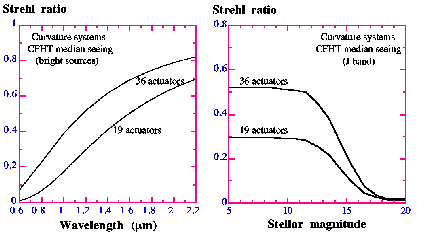 |
 |
Regarding the potential applications of Pueo Nui, they will be best
advocated by the current users of Pueo. We will give here only two examples.
One is the application of Pueo Nui to planetary science. As noted above,
the NASA IRTF is currently being equipped with a 36-actuator curvature
AO system. This will give US astronomers a definite advantage over the
CFHT planetary observers. Pueo Nui will easily outperform the ESO Adonis
system and provide a competitive tool to the French planetary community.
The benefits to planetary science are both an important increase in image
contrast allowing the observer to detect finer details on the surface of
asteroids and planetary satellites or finer structures in planetary atmospheres
and rings, and the ability to observe these objects at shorter wavelengths.
An example of planetary application is shown in Fig. 4.
The other example is the study of AGNs, quasars and starburst
galaxies. Apart from improved correction on bright objects and at
shorter wavelengths (which in itself would be sufficient to warrant such
an upgrade), it is expected that the number of observable sources with
substantial image quality improvement will also increase , even though
the absolute limiting magnitude will not. This is is illustrated on Fig. 5which shows the number of AGNs as a
function of their V magnitude. This curve is extracted from the
Véron&Véron-Cetty catalogue, and even though details may vary, it
gives a fair approximation. Super-imposed on this curve are Strehl
ratio vs. magnitude plots for a 19 and a 36 elements system for the J
band (at K band, we should obtain similar curves with higher absolute
values of Strehl). The dashed horizontal line at a value of ![]() 30% approximately indicates the diffraction limit. It can
tehrefore be seen that the number of extragalactic objects for which
diffraction limited imaging becomes possible increases
dramatically. Coupled with instruments such as OASIS and GRiF, this
upgrade would become a very powerful and unique tool in the study of the
close environment of AGNs and quasars.
30% approximately indicates the diffraction limit. It can
tehrefore be seen that the number of extragalactic objects for which
diffraction limited imaging becomes possible increases
dramatically. Coupled with instruments such as OASIS and GRiF, this
upgrade would become a very powerful and unique tool in the study of the
close environment of AGNs and quasars.